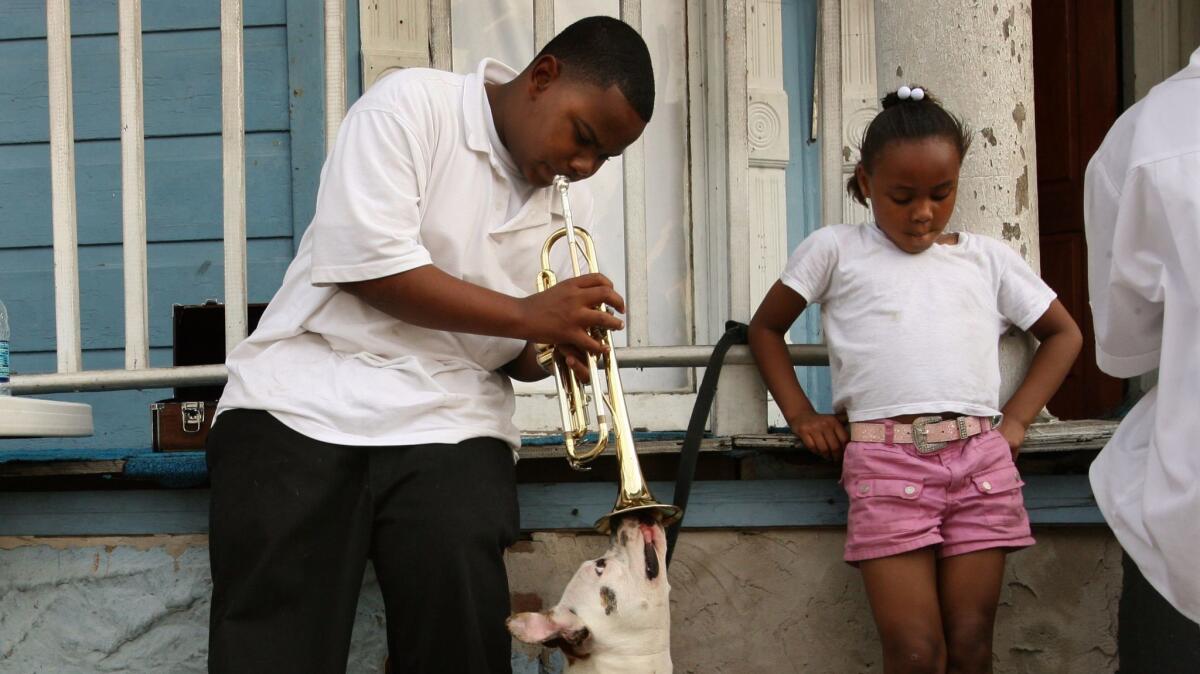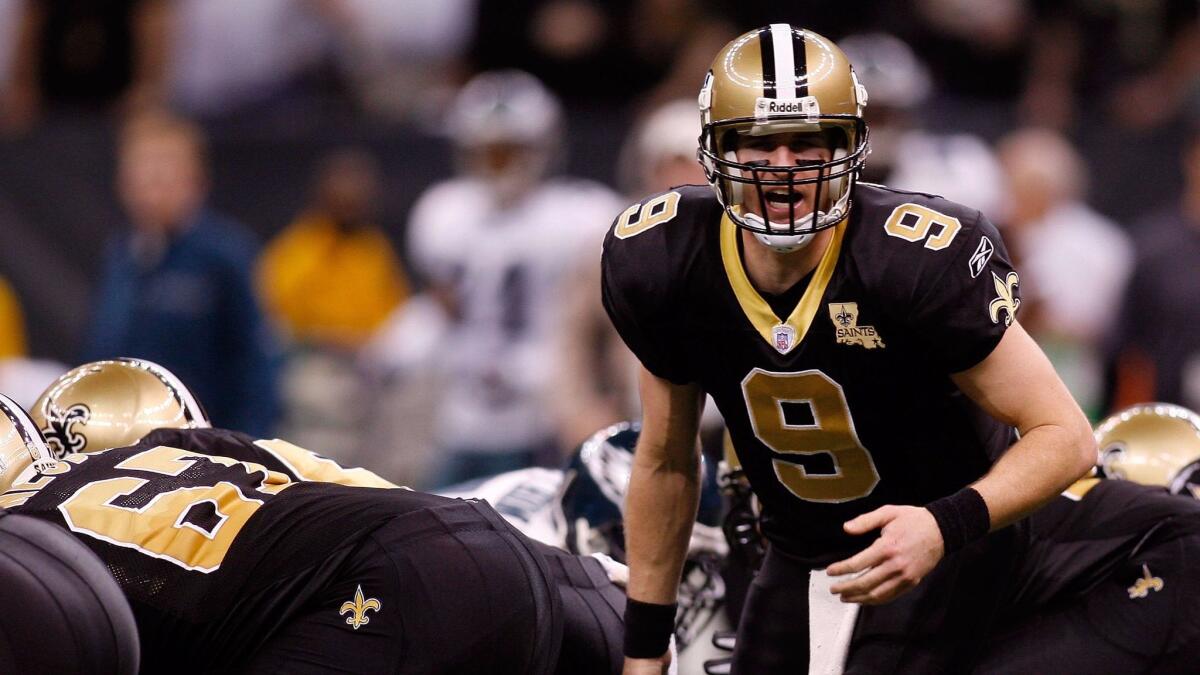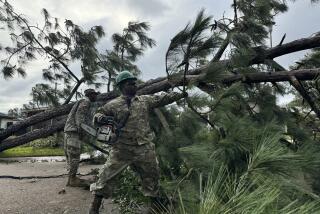From the Archives: What I saw as New Orleans rebuilt after Katrina

Reporting from New Orleans — Editor’s note: Hurricane Katrina made landfall 12 years ago, leaving the Gulf Coast devastated. As we we remember Hurricane Katrina while Hurricane Harvey – now downgraded to a tropical storm – continues to ravage Texas and Louisiana, we look back at Ann Simmons’ conclusion of her stay in New Orleans:
Shortly after arriving in New Orleans in March 2006, I took a wrong turn and headed over a bridge into the city’s Lower 9th Ward, which was still largely deserted after being devastated by Hurricane Katrina.
A knot tightened in my stomach. I had unintentionally broken my self-imposed rule of not traveling into an unfamiliar area late at night.
Suddenly, something darted in front of my car. A small dog, I thought. It turned out to be a rat. Another one followed shortly afterward.
Then I saw him -- someone standing on the sidewalk ahead of me.
My fingers tightened around the steering wheel. Trapped on one side by a levee wall, there was nowhere to go but forward.
I couldn’t drive fast for fear of puncturing a tire. What remained of the buckled road was littered with nail-studded wood, glass shards and spikes from the ruins of destroyed homes.
The figure didn’t move. Could he be armed?
As I approached, I saw that my potential assailant was some kind of post or stump.
Why was I so nervous?
I stand over 6 feet tall, a strong black woman from London who is not easily intimidated. My career as a journalist had put me on the front line of conflicts in Eritrea and Liberia. I had been roughed up at a rally in the Democratic Republic of Congo for supposedly resembling a Banyamulenge, a member of an ethnic group then embroiled in Congo’s civil conflict. I had walked side by side with gun-toting militia members in the former Soviet republic of Georgia, and I survived a suicide bomb attack in Baghdad.
I hadn’t imagined phantoms there. I knew of the risks and had expected danger.
But this was America, and as a Briton by birth, I had a somewhat idealistic view of America the Great. By now, six months after Katrina, there should have been lights in windows, people strolling the sidewalks, the murmur of voices, music wafting from front porches.
Instead, there was the kind of ominous silence that envelops a city under siege until the crackle of gunfire punctures the peace.
The unnatural silence, the nothingness, scared me.
Over my 14 months covering the rebuilding of New Orleans, the city repeatedly brought to mind images and people I had seen in more desperate parts of the developing world.
It was not unusual for the lights to go out, streets to flood, and water pressure in New Orleans neighborhoods to drop to a trickle when it rained. The problem was prevalent at the so-called luxury apartment where I lived, which also served as the Los Angeles Times bureau in the Mid-City area.
Against the background of the enormous physical destruction, such inconveniences should have seemed minor.
But the repeated small indignities mounted and pushed New Orleanians to the edge. Before the storm, everyone took for granted a consistent supply of electricity and potable water, regular mail service, a local supermarket, a bank, a church, a nearby school, and at least one local restaurant, even if it was a fast-food joint.
The unnatural silence, the nothingness, scared me.
For long months after Katrina, most neighborhoods had none of these. Some still don’t.
It took several months to find a dry cleaner, so I only wore clothes that could be washed in a machine, or by hand. The nearest Rite Aid pharmacy operated out of a trailer until October 2006.
Only five doctors remained of the 120 estimated to have been in practice in the neighborhood before August 2005. I typically let my illnesses run their course rather than face the hassle of trying to find a doctor, or I sought medical attention on trips back to L.A.
Most New Orleans residents could not do that. They had to, and still have to, make do with subpar healthcare. Before Katrina, there were 11 area hospitals offering emergency services. Today, there are fewer than half that.
The storm also destroyed or financially hurt more than 80% of Orleans Parish’s small businesses, among them many black hair salons. Managing the short style that I had before moving to New Orleans was a challenge.
One day, I cornered a policewoman shopping at Wal-Mart who was wearing the same style. She gave me her hairdresser’s name, but added that her salon was the only one in the Bywater neighborhood that had reopened, and that it was constantly jammed. Newcomers would probably have to book at least a month in advance, or sit and wait all day. This hardly seemed practical.
I started wearing my hair in extension braids. Andrea Shaw, a colleague and friend from the New Orleans Times-Picayune, referred me to Sarone SunRaa, a veteran of black hair care. She plied her trade from a clean and comfortable room in her home.
This seemingly mundane and vanity-driven experience illustrated what many African Americans meant when they said New Orleans was no longer truly “a black city.” It wasn’t only the physical presence of African Americans that counted, but the many longtime black community institutions, such as barbershops, black-owned corner stores, and traditional Social Aid and Pleasure Clubs -- benevolent societies that are famous for their parasol-twirling, brass-band “second line” jazz parades.
Here we were in supposedly the world’s most powerful industrialized nation, yet getting New Orleans back on its feet was so slow. Federal, state and city officials continue to blame each other for the lethargic progress.
My perception of the United States as a democracy that takes care of its own was shattered.
This wasn’t Somalia of the 1990s, where the absence of a central government guaranteed a dearth of public services and shoddy infrastructure; or postwar Angola, where broken bridges, land mines and derelict roads and airstrips could be blamed for hampering the transport of supplies or assistance to a populace in need. It wasn’t southern Sudan, where aid groups often had to suspend relief efforts because of security concerns.
This was America.
The lack of faith in the government, common among people in the developing world, gradually began to show itself among New Orleanians as they waited in vain for an outpouring of help from authorities.
“It’s like no one cares; like we’ve been forgotten,” Marie Benoit, a schoolteacher pre-Katrina, said one day on the way to her home in a park of 500 campers on the campus of Southern University at New Orleans.
It was a sentiment that echoed continually -- feelings of rejection, that New Orleans was not part of the United States, that maybe those internally displaced or living in exile were indeed “refugees.” (New Orleanians despise that term.)
Expectation gave way to resignation -- a gradual unconscious acceptance that New Orleanians were essentially on their own. A greater community spirit emerged from that realization. Neighborhood associations were founded, or came back to life. They brought neighbors together, sometimes for the first time, and encouraged people to get involved in the city’s future.
It’s like no one cares; like we’ve been forgotten
— Marie Benoit, a schoolteacher pre-Katrina
“It’s going to take everyone who’s still left living here to get involved,” said homemaker Becky Zaheri as she explained her motivation for launching Katrina Krewe, a volunteer community cleanup group of students, homemakers, retirees, teachers and other professionals. “We need all the citizens to take pride in our city, to take ownership of our city.”
Not a day went by during my stay without a mention of the “K” word. No matter the topic, all conversation led back to Katrina: how someone had fared; what they managed to salvage; where they were living; their struggles to rebuild. Many interviews became impromptu therapy sessions.
I always scheduled more time than was necessary just to leave room for the inevitable Katrina tales. Some people had to “talk it out” whenever they got the opportunity.
But being bombarded with raw feelings -- anger and anxiety, denial and defiance, sadness and hope -- was draining. Every day it hit home that Katrina had touched the life of every person in this city, no matter their social or economic standing.
Gordon Natal, a professor of nursing at Loyola University, lived in the city’s upscale Lakewood South suburb, which had literally become a lake in the days after the hurricane.
His 3,000-square-foot house had been flooded almost to its eaves. He was trying to renovate the house while fixing up his backyard pool house so his homeless parents could live there temporarily.
Natal spoke with confidence as he expressed his determination to return home. But as he finished talking, his poise gave way to tears.
It was the fifth time that week that someone had broken down and wept during an interview. Three were grown men. I would press a shoulder comfortingly, mutter words of consolation, or sit in uncomfortable silence allowing the person to grieve.
What do you say to someone who has lost everything they ever owned? That you understood how it felt, when you did not? Saying “I’m sorry” just seemed so lame.
Feelings of inadequacy -- my inability to help people -- overwhelmed me. Relief came through the seven-mile run and gym workout each morning -- and often another session each evening.
By the second anniversary of Katrina, Natal had been back in his house for almost a year. His parents had made his pool house their permanent home.
But life was still a struggle: heavy debt from home repairs, higher property taxes, and utility bills that had doubled. The father of three has been forced to take a second job as an emergency room nurse on weekends. “I would not encourage anybody to return here,” said Natal. “It’s not worth it.”
Throughout my months in New Orleans, my accent elicited curiosity, admiration, amusement and sometimes a measure of disbelief. I often had to explain “what I was”: “No, I’m not South African”; “Yes, there are lots of black people in England.”
Generally, people’s interest helped to break the ice.
“Our people be everywhere,” Dwayne Holmes, a heavyset African American 16-year-old, said with a grin one day as he and his pals sat on a stoop on a street in crime-plagued Central City.
Holmes wanted to know whether black youth in England also called each other “dog” as a term of endearment.
For the most part, we have our own lingo, I told him.
“They treat black people bad there too?” he continued.
This provided an entree to the subject that had brought me to Central City: that African American youth, like Holmes and his mates, were being blamed for a growing wave of violence.
In the summer of 2006, Louisiana’s Democratic Gov. Kathleen Babineaux Blanco dispatched a contingent of National Guard and state troopers after the gunning-down of six people -- five of them teenagers -- over one weekend.
New Orleans has long had a crime problem. Katrina did not create this. But many residents openly acknowledged that they had hoped the storm had swept out the criminals, for good.
The city haltingly crept toward recovery at the outset of 2007, 16 months after Katrina. Annual events like Mardi Gras and the Jazz & Heritage Festival were huge successes.

When the New Orleans Saints qualified for the National Football Conference championship in January, residents were united in their euphoria. Hurt and anxiety over the rebuilding struggle were momentarily swept aside.
The Saints were the first team in the history of the NFL to reach a conference championship after losing 13 or more games the previous season. Their success became a beacon of hope for the city’s recovery.
I don’t understand the rules of American football, but I watched the game with friends at the Dry Dock Cafe at historic Algiers Point.
Black and whites sat festively side by side. The only colors that mattered here were the Saints’ black and gold.
“Who dat say dey gonna beat dem Saints? Who dat? Who dat?” I yelled out the Saints battle cry as running back Reggie Bush scored a touchdown. My accent elicited a ripple of laughter.
A month after the game, D. Majeeda Snead, a clinical professor and criminologist at Loyola, and a justice system source-turned-friend, extended an invitation to the Zulu Ball, a premier event of carnival season.
The annual dance is organized by the Zulu Social Aid & Pleasure Club Inc., New Orleans’ largest, predominantly African American carnival organization. A colleague described the event as “a formal picnic,” because guests typically bring their own food and drink.
That frigid February evening, ladies dressed in ball gowns toted foil trays with fried chicken, sandwiches and hors d’oeuvres. Tuxedo-clad men hauled crates and coolers and bags with bottles of wine and champagne.
New Orleans is coming back, whether you like it or not
— New Orleans Mayor C. Ray Nagin
It took almost two hours to get through the crush of cars and floats to the convention center, where an estimated 15,000 had gathered. Screams of excitement rang out as people who had not seen each other since Katrina embraced and kissed.
Many people were still living outside the city, but had returned specifically for the ball. Revelers shouted “Where you at?” -- a common New Orleans greeting for “How ya doing?” There was a feeling of homecoming as tears blended with laughter.
Throughout the first half of this year, signs of normalcy increased. Many storm-ravaged neighborhoods began to spring back to life: The first new home in the Lower 9th Ward was dedicated in February, though it stood against a backdrop of destruction. By May, more than two dozen businesses had returned to the main commercial strip in the Lakeview area. I left New Orleans the day before the June 1 start of the hurricane season, the second one since Katrina.
The day before, New Orleans Mayor C. Ray Nagin gave his first State of the City address since Katrina. He berated federal and state leaders for breaking promises to provide adequate financial assistance to New Orleans “and people who need it the most.” He insisted the city was on the mend.
“New Orleans is coming back, whether you like it or not,” Nagin said, “and you might as well deal with it.”
I regretted leaving this dynamic and offbeat city, its compelling story and its resilient people.
Their heartbreak and struggles were a reminder to never take for granted the basics of everyday existence.
But overall, there was a measure of hope now. No matter how long it took, New Orleans would come back.
I remembered the mood during the Saints’ campaign for the Super Bowl. Although the team lost, the city won. It got a second wind. It simply refused to be beaten.
This was the America I knew.
More to Read
Sign up for Essential California
The most important California stories and recommendations in your inbox every morning.
You may occasionally receive promotional content from the Los Angeles Times.











